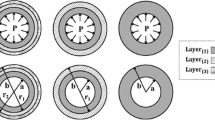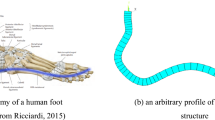Abstract
The investigation of possible failures in composite materials is a matter of very great importance, and the Tsai-Wu criterion is an effective criterion for analyzing those flaws in anisotropic materials and defining whether the material at a given load will or will not suffer structural failure. In this study, an optimization procedure is proposed to minimize the maximum value of Tsai-Wu of laminated composite tubes subject to axial loading. Artificial neural networks and genetic algorithms are chosen as optimization tools. The results of this study show that the developed algorithm converges faster. Then, the maximum Tsai-Wu value is used as the objective function and the fiber orientations are the constraints in the optimization process. The results yielded by them are compared and discussed. Optimal results are compared with respect to the usual initial design. The design approach is recommended for structures where composites are the key load-carrying members such as orthopedic prosthesis.








Similar content being viewed by others
References
C.A.R. Brito Jr., E.M. Bezerra, L.C. Pardini, A.C. Ancelotti Jr., M.S. Pereira, E. Barros, L.R. Camargo, Redes neurais artificiais aplicadas para predição do comportamento dinâmico-mecânico de compósitos de matriz epóxi reforçados com fibras de carbono. Revista matéria 12(2), 346–357 (2007)
F.C. Campbell, Structural Composite Materials (ASM Internacional, New York, 2010)
E.K.P. Chong, S.H. Zak, An Introduction to Optimization (Wiley, Etobicoke, 2001)
D.I.G. Costa, E.L. Albuquerque, A. Reis, G. Panosso, P. Sollero, Análise numérica de falhas em laminados usando um critério baseado em fenômenos físicos. Mecànica Computaciona 29(51), 5173–5187 (2010)
I.M. Daniel, O. Ishai, I.M.I. Daniel, Engineering Mechanics of Composite Materials, vol. 3 (Oxford University Press, New York, 1994), p. 256
A. De Fenza, A. Sorrentino, P. Vitiello, Application of Artificial Neural Networks and Probability Ellipse methods for damage detection using Lamb waves. Compos. Struct. 133, 390–403 (2015)
Kalyanmoy Deb, An efficient constraint handling method for genetic algorithms. Comput. Methods Appl. Mech. Eng. 186(2), 311–338 (2000)
Hubert Debski, Jozef Jonak, Failure analysis of thin-walled composite channel section columns. Compos. Struct. 132, 567–574 (2015)
K. Deep, K.P. Singh, M.L. Kansal, C. Mohan, A real coded genetic algorithm for solving integer and mixed integer optimization problems. Appl. Math. Comput. 212(2), 505–518 (2009)
S. Haykin, Neural Networks and Learning Machines (Pearson, New York, 2009)
A.K. Kaw, Mechanics of Composite Materials (CRC Press, Boca Raton, 2005)
M. Koc, F.O. Sonmez, N. Ersoy, K. Cinar, Failure behavior of composite laminates under four-point bending. J. Compos. Mater. 50(26), 3679–3697 (2016)
A.J. Kolios, Stefano Proia, Evaluation of the reliability performance of failure criteria for composite structures. World J. Mech. 2(03), 162 (2012)
Z.L. Kovács, Redes neurais artificiais (Editora Livraria da Fisica, Sao Paulo, 2002)
U.K. Mallela, A. Upadhyay, Buckling load prediction of laminated composite stiffened panels subjected to in-plane shear using artificial neural networks. Thin-Walled Struct. 102, 158–164 (2016)
A.T.D. Martins, Projeto e fabricação de tubos compósitos em fibras de carbono/epóxi para próteses transtibiais por moldagem com bladder. Dissertação (Mestrado), Engenharia Mecânica, Universidade Federal de Itajubá (2015)
S. Mazumdar, Composites manufacturing materials, product, and process engineering (CRC Press, Boca Raton, 2001)
M. Mitchell, An Introduction to Genetic Algorithms (MIT Press, Cambridge, 1998)
D.C. Montgomery, E.A. Peck, G. Geoffrey-Vining, Introduction to Linear Regression Analysis (Wiley, Hoboken, 2015)
P. Selva, O. Cherrier, V. Budinger, F. Lachaud, J. Morlier, Smart monitoring of aeronautical composites plates based on electromechanical impedance measurements and artificial neural networks. Eng. Struct. 56, 794–804 (2013)
S.W. Tsai, E.M. Wu, A general theory of strength for anisotropic materials. J. Compos. Mater. 5(1), 58–80 (1971)
C. Velmurugan, V. Muthukumaran, K. Ragupathy, S. Ragunath, Modeling volume loss of heat treated Al 6061 composites using an artificial neural network. Procedia Mater. Sci. 5, 31–40 (2014)
G.Z. Voyiadjis, P.I. Kattan, Mechanics of composite materials with MATLAB (Springer, USA, 2005)
X.-S. Yang, Engineering optimization: an introduction with metaheuristic applications (Wiley, Hoboken, 2010)
B. Yegnanarayana, Artificial Neural Networks (PHI Learning Pvt. Ltd., New York, 2009)
Acknowledgments
The authors would like to acknowledge the financial support from the Brazilian agency CNPq—Conselho Nacional de Desenvolvimento Científico e Tecnológico and CAPES—Coordenação de Aperfeiçoamento de Pessoal de Nível Superior.
Conflict of interest
The authors declare that there is no conflict of interest regarding the publication of this paper.
Author information
Authors and Affiliations
Corresponding author
Rights and permissions
About this article
Cite this article
Gomes, G.F., Diniz, C.A., da Cunha, S.S. et al. Design Optimization of Composite Prosthetic Tubes Using GA-ANN Algorithm Considering Tsai-Wu Failure Criteria. J Fail. Anal. and Preven. 17, 740–749 (2017). https://doi.org/10.1007/s11668-017-0304-5
Received:
Revised:
Published:
Issue Date:
DOI: https://doi.org/10.1007/s11668-017-0304-5




